New 5-Aminotetrazole-Based Energetic Polymers: Synthesis, Structure and Properties
Abstract
1. Introduction
2. Materials and Methods
3. Results and Discussion
3.1. Synthesis and Chemical Structure Analysis
3.2. Thermal Stability, Nitrogen Content and Density
3.3. Viscosity Characteristics and Curing Rheokinetics
4. Conclusions
Author Contributions
Funding
Institutional Review Board Statement
Informed Consent Statement
Data Availability Statement
Acknowledgments
Conflicts of Interest
References
- Ang, H.G.; Pisharath, S. Energetic Polymers: Binders and Plasticizers for Enhancing Performance; Wiley-VCH: Weinheim, Germany, 2012; p. 218. [Google Scholar]
- Cheng, T. Review of Novel Energetic Polymers and Binders–High Energy Propellant Ingredients for the New Space Race. Des. Monomers Polym. 2019, 22, 54–65. [Google Scholar] [CrossRef] [PubMed]
- Nazare, A.N.; Asthana, S.N.; Singh, H. Glycidyl Azide Polymer (GAP)—An Energetic Component of Advanced Solid Rocket Propellants—A Review. J. Energetic Mater. 1992, 10, 43–63. [Google Scholar] [CrossRef]
- Zhang, L.; Su, X.; Wang, S.; Li, X.; Zou, M. In situ preparation of Al@3-Perfluorohexyl-1, 2-epoxypropane@glycidyl azide polymer (Al@PFHP@GAP) high-energy material. Chem. Eng. J. 2022, 137118. [Google Scholar] [CrossRef]
- Hafner, S.; Keicher, T.; Klapötke, T.M. Copolymers Based on GAP and 1,2-Epoxyhexane as Promising Prepolymers for Energetic Binder Systems. Propellants Explos. Pyrotech. 2017, 43, 126–135. [Google Scholar] [CrossRef]
- Eroǧlu, M.S.; Güven, O. Termal Decomposition of Poly(glycidyl azide) as Studied by High-temperature FTIR and Thermogravimetry. J. Appl. Polym. Sci. 1996, 61, 201–206. [Google Scholar] [CrossRef]
- Selim, K.; Ozkar, S.; Yilmaz, L. Thermal Characterization of Glycidyl Azide Polymer (GAP) and GAP-based Binders for Composite Propellants. J. Appl. Polym. Sci. 2000, 77, 538–546. [Google Scholar] [CrossRef]
- Li, Y.; Ren, H.; Wu, X.; Wang, H.; Yu, X. Nitrogen-rich Energetic Polymer Powered Aluminum Particles with Enhanced Reactivity and Energy Content. Sci. Rep. 2022, 12, 8893. [Google Scholar] [CrossRef] [PubMed]
- Hussein, A.K.; Elbeih, A.; Zeman, S. The Effect of Glycidyl Azide Polymer on the Stability and Explosive Properties of Different Interesting Nitramines. RSC Adv. 2018, 8, 17272–17278. [Google Scholar] [CrossRef] [PubMed]
- Hafner, S.; Hartdegen, V.A.; Hofmayer, M.S.; Klapötke, T.M. Potential Energetic Plasticizers on the Basis of 2,2-Dinitropropane-1,3-diol and 2,2-Bis(azidomethyl)propane-1,3-diol. Propellants Explos. Pyrotech. 2016, 41, 806–813. [Google Scholar] [CrossRef]
- Ye, B.; An, C.; Wang, J.; Li, H.; Ji, W.; Gao, K. Preparation and Characterization of RDX-Based Composite with Glycidyl Azide Polymers and Nitrocellulose. J. Propuls. Power 2016, 32, 1036–1040. [Google Scholar] [CrossRef]
- Yanju, W.; Jingyu, W.; Chongwei, A.; Hequn, L.; Xiaomu, W.; Binshuo, Y. GAP/CL-20-Based Compound Explosive: A New Booster Formulation Used in a Small-Sized Initiation Network. J. Energetic Mater. 2016, 35, 53–62. [Google Scholar] [CrossRef]
- Murali Mohan, Y.; Mani, Y.; Mohana Raju, K. Synthesis of Azido Polymers as Potential Energetic Propellent Binders. Des. Monomers Polym. 2006, 9, 201–236. [Google Scholar] [CrossRef]
- Jarosz, T.; Stolarczyk, A.; Wawrzkiewicz-Jalowiecka, A.; Pawlus, K.; Miszczyszyn, K. Glycidyl Azide Polymer and Its Derivatives-Versatile Binders for Explosives and Pyrotechnics: Tutorial Review of Recent Progress. Molecules 2019, 24, 4475. [Google Scholar] [CrossRef] [PubMed]
- Eroglu, M.S.; Bostan, M.S. Gap Pre-Polymer, as an Energetic Binder and High Performance Additive for Propellants and Explosives: A Review. Org. Commun. 2017, 10, 135–143. [Google Scholar] [CrossRef]
- Li, P.; Li, Q.; Li, X.L.; Gan, X.X.; Yu, H.J. Research on the Mechanical Property of GAP Copolymer Elastomer. Chin. J. Explos. Propellants 2000, 23, 23–28. [Google Scholar]
- Born, M.; Karaghiosoff, K.; Klapötke, T.M. A GAP Replacement: Improved Synthesis of 3-Azidooxetane and Its Homopolymer Based on Sulfonic Acid Esters of Oxetan-3-ol. J. Org. Chem. 2021, 86, 12607–12614. [Google Scholar] [CrossRef] [PubMed]
- Born, M.; Fessard, T.C.; Göttemann, L.; Plank, J.; Klapötke, T.M. A GAP Replacement, Part 2: Preparation of Poly(3-azidooxetane) via Azidation of Poly(3-tosyloxyoxetane) and Poly(3-mesyloxyoxetane). J. Org. Chem. 2022, 87, 4097–4106. [Google Scholar] [CrossRef] [PubMed]
- Betzler, F.M.; Hartdegen, V.A.; Klapötke, T.M.; Sproll, S.M. A New Energetic Binder: Glycidyl Nitramine Polymer. Cent. Eur. J. Energetic Mater. 2016, 13, 289–300. [Google Scholar] [CrossRef]
- Nešić, J.; Marinkovic, A.; Bajić, Z.; Brzić, S.J. Synthesis and Characterization Glycidyl Azide Polymer of an Attractive Binder for Energetic Materials. Sci. Tech. Rev. 2018, 68, 26–35. [Google Scholar] [CrossRef]
- Song, Y.; Xiao, L.; Jian, X.; Zhou, W.; He, X. Synthesis and Characterization of a Novel Aqueous Glycidyl Azide Polymer Emulsion. ACS Omega 2021, 6, 32081–32089. [Google Scholar] [CrossRef]
- Ghoroghchian, F.; Bayat, Y.; Abrishami, F. Synthesis and Optimization of Polypropylene Glycol-Glycidyl Azide Polymer-Polypropylene Glycol as a Novel Triblock Copolymer Binder. J. Chem. Sci. 2020, 132, 106. [Google Scholar] [CrossRef]
- Sukhanov, G.T.; Bosov, K.K.; Sukhanova, A.G.; Filippova, Y.V.; Krupnova, I.A.; Pivovarova, E.V. Synthesis and Properties of Glycidyl Polymers Bearing 1,2,4-Triazol-5-One, 3-Nitro-1,2,4-Triazol-5-One and Glycidyl Azide Units. Propellants Explos. Pyrotech. 2021, 46, 1526–1536. [Google Scholar] [CrossRef]
- Xu, M.; Ge, Z.; Lu, X.; Mo, H.; Ji, Y.; Hu, H. Fluorinated Glycidyl Azide Polymers as Potential Energetic Binders. RSC Adv. 2017, 7, 47271–47278. [Google Scholar] [CrossRef]
- Kim, H.; Jang, Y.; Noh, S.; Jeong, J.; Kim, D.; Kang, B.; Kang, T.; Choi, H.; Rhee, H. Ecofriendly Synthesis and Characterization of Carboxylated GAP copolymers. RSC Adv. 2018, 8, 20032–20038. [Google Scholar] [CrossRef] [PubMed]
- Xu, M.; Lu, X.; Liu, N.; Zhang, Q.; Mo, H.; Ge, Z. Fluoropolymer/Glycidyl Azide Polymer (GAP) Block Copolyurethane as New Energetic Binders: Synthesis, Mechanical Properties, and Thermal Performance. Polymers 2021, 13, 2706. [Google Scholar] [CrossRef] [PubMed]
- Mohan, Y.M.; Raju, M.P.; Raju, K.M. Synthesis, Spectral and DSC Analysis of Glycidyl Azide Polymers Containing Different Initiating Diol Units. J. Appl. Polym. Sci. 2004, 93, 2157–2163. [Google Scholar] [CrossRef]
- Betzler, F.M.; Klapötke, T.M.; Sproll, S. Energetic Nitrogen-Rich Polymers Based on Cellulose, Cent. Eur. J. Energetic Mater. 2011, 8, 157–171. [Google Scholar]
- Tarchoun, A.F.; Trache, D.; Klapötke, T.M.; Khimeche, K. Tetrazole-Functionalized Microcrystalline Cellulose: A Promising Biopolymer for Advanced Energetic Materials. Chem. Eng. J. 2020, 400, 125960. [Google Scholar] [CrossRef]
- Gaponik, P.N.; Ivashkevich, O.A.; Karavai, V.P.; Lesnikovich, A.I.; Chernavina, N.I.; Sukhanov, G.T.; Gareev, G.A. Polymers and Copolymers Based on Vinyl Tetrazoles. 1. Synthesis of Poly(5-vinyltetrazole) by Polymer-analogous Conversion of Polyacrylonitrile. Angew. Makromol. Chem. 1994, 219, 77–88. [Google Scholar] [CrossRef]
- Klapötke, T.M.; Sproll, S.M. Investigation of Nitrogen-rich Energetic Polymers Based on Alkylbridged bis-(1-methyl-tetrazolylhydrazines). J. Polym. Sci. Part A Polym. Chem. 2010, 48, 122–127. [Google Scholar] [CrossRef]
- Kizhnyaev, V.N.; Golobokova, T.V.; Pokatilov, F.A.; Vereshchagin, L.I.; Estrin, Y.I. Synthesis of Energetic Triazole- and Tetrazole-containing Oligomers and Polymers. Chem. Heterocycl. Compd. 2017, 53, 682–692. [Google Scholar] [CrossRef]
- Mahkam, M.; Nabati, M.; Latifpour, A.; Aboudi, J. Synthesis and Characterization of New Nitrogen-Rich Polymers as Candidates for Energetic Applications. Des. Monomers Polym. 2014, 17, 453–457. [Google Scholar] [CrossRef]
- Kshirsagar, A.D.; Hundiwale, D.G.; Gite, V.V.; Mahulikar, P.P. Microwave-Mediated Synthesis of Poly{[p-(azidomethyl)styrene]-co-(5-vinyltetrazole)} as an Energetic Polymer. Chem. Heterocycl. Compd. 2017, 53, 1090–1093. [Google Scholar] [CrossRef]
- Shin, L.-A.; Lim, Y.-G.; Lee, K.-H. Synthesis of Polymers Including Both Triazole and Tetrazole by Click Reaction. Bull. Korean Chem. Soc. 2011, 32, 547–552. [Google Scholar] [CrossRef]
- Mahkam, M.; Jahanbani-Korabbaslo, S.; Fathi, R.; Nazmi, L.; Rezaii, E. Synthesis and Characterization of Novel Micro-sized Tetrazole-based High Energetic Nitrogen-rich Polymers. Commun. Catal. 2018, 1, 58–66. [Google Scholar]
- Li, Y.; Yu, T.; Zhang, Y.; Hu, J.; Chen, T.; Wang, Y.; Xu, K. Novel Energetic Coordination Polymers Based on 1,5-Di(nitramino)tetrazole With High Oxygen Content and Outstanding Properties: Syntheses, Crystal Structures, and Detonation Properties. Front. Chem. 2019, 7, 672. [Google Scholar] [CrossRef] [PubMed]
- Betzler, F.M.; Klapötke, T.M.; Sproll, S.M. Synthesis of Glycidyl-5-(carboxyethyl-1H-tetrazole)polymer and 1,2-Bis(5-carboxyethyl-1H-tetrazolyl)ethane as Polymeric Precursor. Eur. J. Org. Chem. 2013, 3, 509–514. [Google Scholar] [CrossRef]
- Huang, W.; Yin, Z.; Dong, Y.; Liu, Y.; Tang, Y. An Energetic Coordination Polymer with High Thermal Stability and Initiation Power. Propellants Explos. Pyrotech. 2022, 47, e202200011. [Google Scholar] [CrossRef]
- Jafari, M.; Ghani, K.; Keshavarz, M.H.; Derikvandy, F. Assessing the Detonation Performance of New Tetrazole Base High Energy Density materials. Propellants Explos. Pyrotech. 2018, 43, 1236–1244. [Google Scholar] [CrossRef]
- Nasrollahzadeh, M.; Nezafat, Z.; Sadat Soheili Bidgoli, N.; Shafiei, N. Use of Tetrazoles in Catalysis and Energetic Applications: Recent Developments. Mol. Catal. 2021, 513, 111788. [Google Scholar] [CrossRef]
- Han, Z.Y.; Zhang, Y.P.; Du, Z.M.; Li, Z.Y.; Yao, Q.; Yang, Y.Z. The Formula Design and Performance Study of Gas Generators based on 5-Aminotetrazole. J. Energetic Mater. 2018, 36, 61–68. [Google Scholar] [CrossRef]
- Fischer, D.; Klapötke, T.M.; Piercey, D.G.; Stierstorfer, J. Synthesis of 5-Aminotetrazole-1N-oxide and Its Azo Derivative: A Key Step in the Development of New Energetic Materials. Chem. Eur. J. 2013, 19, 4602–4613. [Google Scholar] [CrossRef] [PubMed]
- Stierstorfer, J.; Tarantik, K.; Klapötke, T.M. New Energetic Materials: Functionalized 1-Ethyl-5-aminotetrazoles and 1-Ethyl-5-nitriminotetrazoles. Chem. Eur. J. 2009, 15, 5775–5792. [Google Scholar] [CrossRef] [PubMed]
- Tang, H.; Zhou, Z.; Li, Z.; Chen, S.; Wang, L.; Zhang, T. Copper (II) Complexes of 1-Methyl-5-aminotetrazole with Different Energetic Anions: Syntheses, Crystal Structures and Properties. J. Energetic Mater. 2021, 39, 23–32. [Google Scholar] [CrossRef]
- Betzler, F.M.; Boller, R.; Grossmann, A.; Klapötke, T.M. Novel Insensitive Energetic Nitrogen-Rich Polymers Based on Tetrazoles. Z. Naturforsch. B J. Chem. Sci. 2013, 68, 714–718. [Google Scholar] [CrossRef]
- Klapötke, T.M.; Stierstorfer, J. Nitration Products of 5-Amino-1H-tetrazole and Methyl-5-amino-1H-tetrazoles—Structures and Properties of Promising Energetic Materials. Helv. Chim. Acta 2007, 90, 2132–2150. [Google Scholar] [CrossRef]
- Fischer, N.; Klapötke, T.M.; Stierstorfer, J. New Nitriminotetrazoles—Synthesis, Structures and Characterization. Z. Anorg. Allg. Chem. 2009, 635, 271–281. [Google Scholar] [CrossRef]
- Klapötke, T.M.; Martin, F.A.; Stierstorfer, J. N-Bound Primary Nitramines Based on 1,5-Diaminotetrazole. Chem. Eur. J. 2012, 18, 1487–1501. [Google Scholar] [CrossRef]
- Benz, M.; Klapötke, T.M.; Lenz, T.; Stierstorfer, J. Tuning the Properties of 5-Azido and 5-Nitraminotetrazoles by Diverse Functionalization—General Concepts for Future Energetic Materials. Chem. Eur. J. 2022, 28, e202200772. [Google Scholar] [CrossRef]
- Fischer, N.; Klapötke, T.M.; Stierstorfer, J.; Wiedemann, C. 1-Nitratoethyl-5-nitriminotetrazole Derivatives—Shaping Future High Explosives. Polyhedron 2011, 30, 2374–2386. [Google Scholar] [CrossRef]
- Fischer, D.; Klapötke, T.M.; Stierstorfer, J. 1,5-Di(nitramino)tetrazole: High Sensitivity and Superior Explosive Performance. Angew. Chem. Int. Ed. 2015, 54, 10299–10302. [Google Scholar] [CrossRef] [PubMed]
- Ernst, V.; Klapötke, T.M.; Stierstorfer, J. Alkali Salts of 5-Aminotetrazole—Structures and Properties. Z. Anorg. Allg. Chem. 2007, 633, 879–887. [Google Scholar] [CrossRef]
- Mourer, M.; Hapiot, F.; Tilloy, S.; Monflier, E.; Menuel, S. Easily Accessible Mono- and Polytopic β-Cyclodextrin Hosts by Click Chemistry. Eur. J. Org. Chem. 2008, 34, 5723–5730. [Google Scholar] [CrossRef]
- Gaponik, P.N.; Karavai, V.P. Synthesis and Properties of 1-(2-Hydroxyethyl)tetrazole. Chem. Heterocycl. Compd. 1985, 21, 1172–1174. [Google Scholar] [CrossRef]
- St-Charles, J.-C.; Dubois, C. Preparation of Azido Polycarbonates via Bulk Polymerization of Halogenated Diols. Propellants Explos. Pyrotech. 2020, 45, 889–897. [Google Scholar] [CrossRef]
- Zhang, G.; Li, J.; Sun, S.; Luo, Y. Azido-terminated Hyperbranched Multi-arm Copolymer as Energetic Macromolecular Plasticizer. Propellants Explos. Pyrotech. 2019, 44, 345–354. [Google Scholar] [CrossRef]
- Mura, C.; Fruci, S.; Lamia, P.; Cappello, M.; Filipi, S.; Polacco, G. Synthesis of GAP and PAMMO Homopolymers from Mesylate Polymeric Precursors. J. Energetic Mater. 2016, 34, 216–233. [Google Scholar] [CrossRef]
- Barbieri, U.; Polacco, G.; Massimi, R. Synthesis of Energetic Polyethers from Halogenated Precursors. Macromol. Symp. 2006, 234, 51–58. [Google Scholar] [CrossRef]
- Kawamoto, A.M.; Keicher, T.; Krause, H.; Holanda, S.J.A. Synthesis and Characterization of Energetic Oxetane-Oxirane-Polymers for Use in Thermoplastic Elastomer Binder systems. In Proceedings of the 36th Annual Conference of the Fraunhofer ICT, Karlsruhe, Germany, 28 June–1 July 2005; pp. 195.1–195.14. [Google Scholar]
- Liu, W.; Liu, W.L.; Pang, S.P. Structures and Properties of Energetic Cations in Energetic Salts. RSC Adv. 2017, 7, 3617–3627. [Google Scholar] [CrossRef]
- Karaghiosoff, K.; Klapötke, T.M.; Mayer, P.; Sabaté, C.M.; Penger, A.; Welch, J.M. Salts of Methylated 5-Aminotetrazoles with Energetic Anions. Inorg. Chem. 2008, 47, 1007–1019. [Google Scholar] [CrossRef]
- Wang, J.-P.; Yi, W.-B.; Cai, C. An Improved Method for the Preparation of Energetic Aminotetrazolium Salts. Z. Anorg. Allg. Chem. 2012, 638, 53–55. [Google Scholar] [CrossRef]
- Von Denffer, M.; Klapötke, T.M.; Kramer, G.; Spieß, G.; Welch, J.M.; Heeb, G. Improved Synthesis and X-ray Structure of 5-Aminotetrazolium Nitrate. Propellants Explos. Pyrotech. 2005, 30, 191–195. [Google Scholar] [CrossRef]
- Klapötke, T.M.; Miró Sabaté, C.; Penger, A.; Rusan, M.; Welch, J.M. Energetic Salts of Low-Symmetry Methylated 5-Aminotetrazoles. Eur. J. Inorg. Chem. 2009, 7, 880–896. [Google Scholar] [CrossRef]
- Tan, B.-J.; Ren, J.-T.; Duan, B.-H.; Xu, M.-H.; Chen, S.-L.; Zhang, H.; Liu, N. Facile Synthesis and Superior Properties of a Nitrogen-Rich Energetic Zn-MOF with a 2D Azide-Bridged Bilayer structure. Dalton Trans. 2022, 51, 7804. [Google Scholar] [CrossRef]
- Zhang, J.G.; Feng, L.N.; Zhang, S.W.; Zhang, T.L.; Zheng, H.H. The Mechanism and Kinetics of Decomposition of 5-Aminotetrazole. J. Mol. Model. 2008, 14, 403–408. [Google Scholar] [CrossRef] [PubMed]
- Kizhnyaev, V.N.; Vereshchagin, L.I. Vinyltetrazoles: Synthesis and Properties, Russ. Chem. Rev. 2003, 72, 143–164. [Google Scholar]
- Gatfaoui, S.; Issaoui, N.; Brandan, S.A.; Roisnel, T.; Marouani, H. Synthesis and Characterization of p-xylylenediaminium bis(nitrate). Effects of the Coordination Modes of Nitrate Groups on Their Structural and Vibrational Properties. J. Mol. Struct. 2018, 1151, 152–168. [Google Scholar] [CrossRef]
- Khanlari, T.; Bayat, Y.; Bayat, M.; Sheibani, N. Synthesis, Characterization, and Curing of Propylene Oxide and Glycidyl Nitrate Random Copolymer (GN-ran-PO) and Investigation of Its Compatibility with Different Energetic Plasticizers. J. Mol. Struct. 2021, 1231, 130008. [Google Scholar] [CrossRef]
- Henry, R.A.; Finnegan, W.G. Mono-alkylation of Sodium 5-Aminotetrazole in Aqueous Medium. J. Am. Chem. Soc. 1954, 76, 923–926. [Google Scholar] [CrossRef]
- Einberg, F. Alkylation of 5-Substituted Tetrazoles with α-Chlorocarbonyl Compounds. J. Org. Chem. 1970, 35, 3978–3980. [Google Scholar] [CrossRef]
- Miró Sabaté, C.; Delalu, H. Methylated Azoles, 2-Tetrazenes, and Hydrazines. Z. Anorg. Allg. Chem. 2014, 640, 1843–1854. [Google Scholar] [CrossRef]
- Pokatilov, F.A.; Kizhnyaev, V.N.; Akamova, E.V.; Edel’shtein, O.A. Effect of Alkylation of Tetrazole Rings on the Properties of Carbochain and Heterochain Tetrazole-Containing Polymers. Polym. Sci. Ser. B 2020, 62, 190–195. [Google Scholar] [CrossRef]
- Kizhnyaev, V.N.; Pokatilov, F.A.; Vereshchagin, L.I. Branched Tetrazole-containing Polymers. Polym. Sci. Ser. A 2007, 49, 28–34. [Google Scholar] [CrossRef]
- Kizhnyaev, V.N.; Pokatilov, F.A.; Vereshchagin, L.I. Carbochain Polymers with Oxadiazole, Triazole, and Tetrazole Cycles. Polym. Sci. Ser. C 2008, 50, 1–21. [Google Scholar] [CrossRef]
- Kumari, D.; Banerjee, S. Rheological Studies of Energetic Binder-plasticizer Blends. Mater. Res. Innov. 2021, 25, 434–441. [Google Scholar] [CrossRef]
- Araya-Marchena, M.; St-Charles, J.-C.; Dubois, C. Investigations on Non-isocyanate Based Reticulation of Glycidyl Azide Pre-polymers. Propellants Explos. Pyrotech. 2019, 44, 769–775. [Google Scholar] [CrossRef]
- Keicher, T.; Kuglstatter, W.; Eisele, S.; Wetzel, T.; Krause, H. Isocyanate-Free Curing of Glycidyl Azide Polymer (GAP) with Bis-Propargyl-Succinate (II). Propellants Explos. Pyrotech. 2009, 34, 210–217. [Google Scholar] [CrossRef]
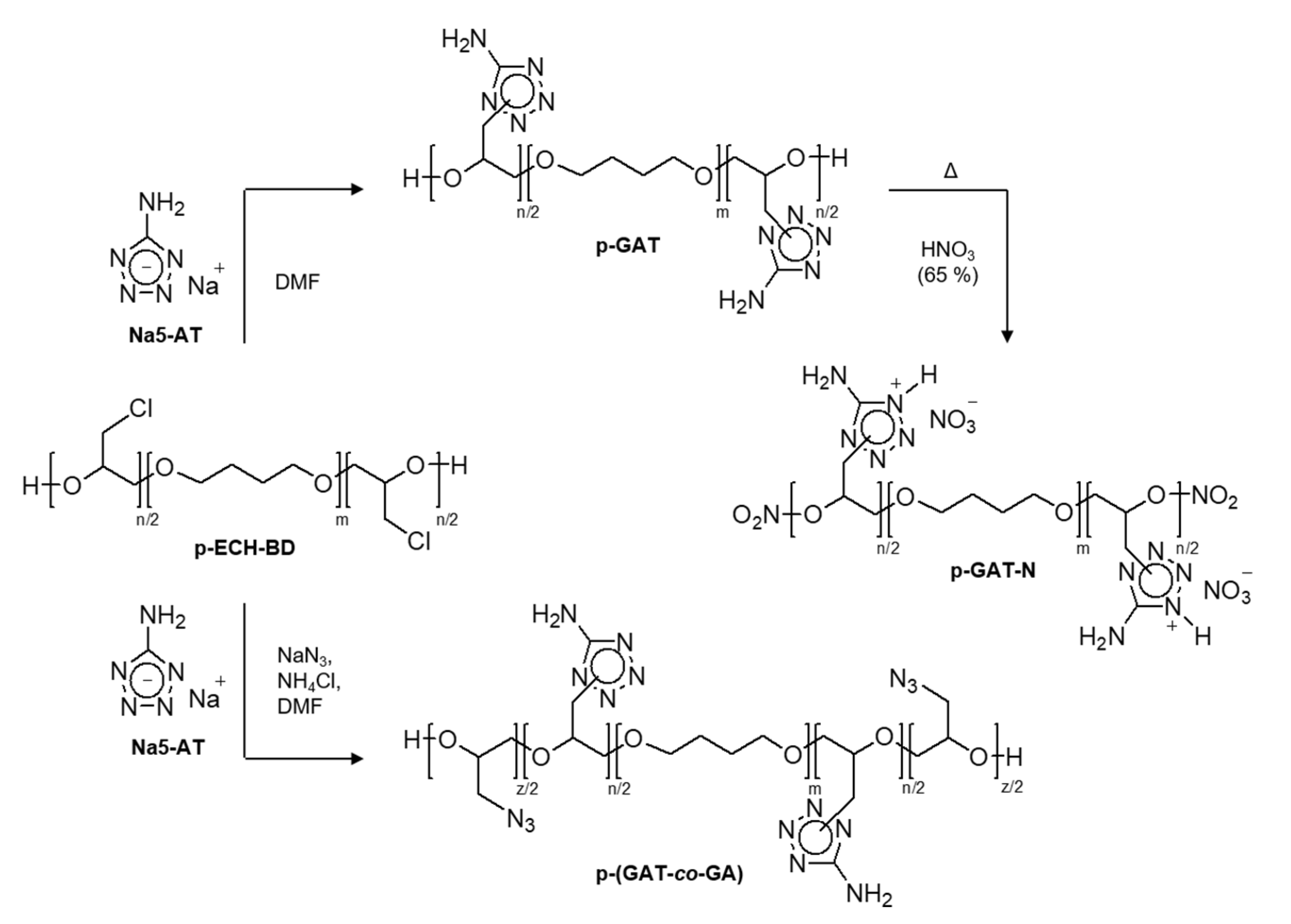

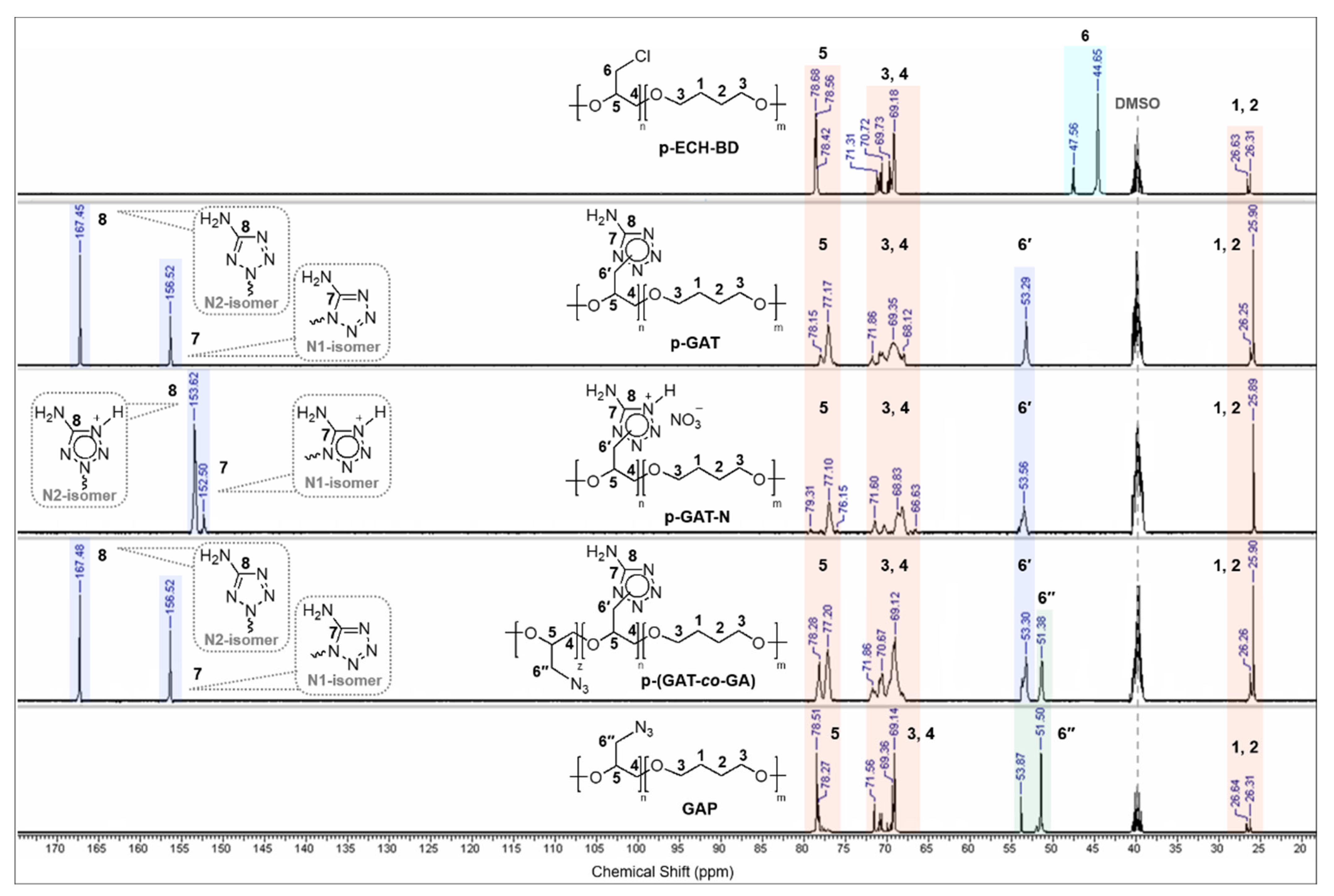

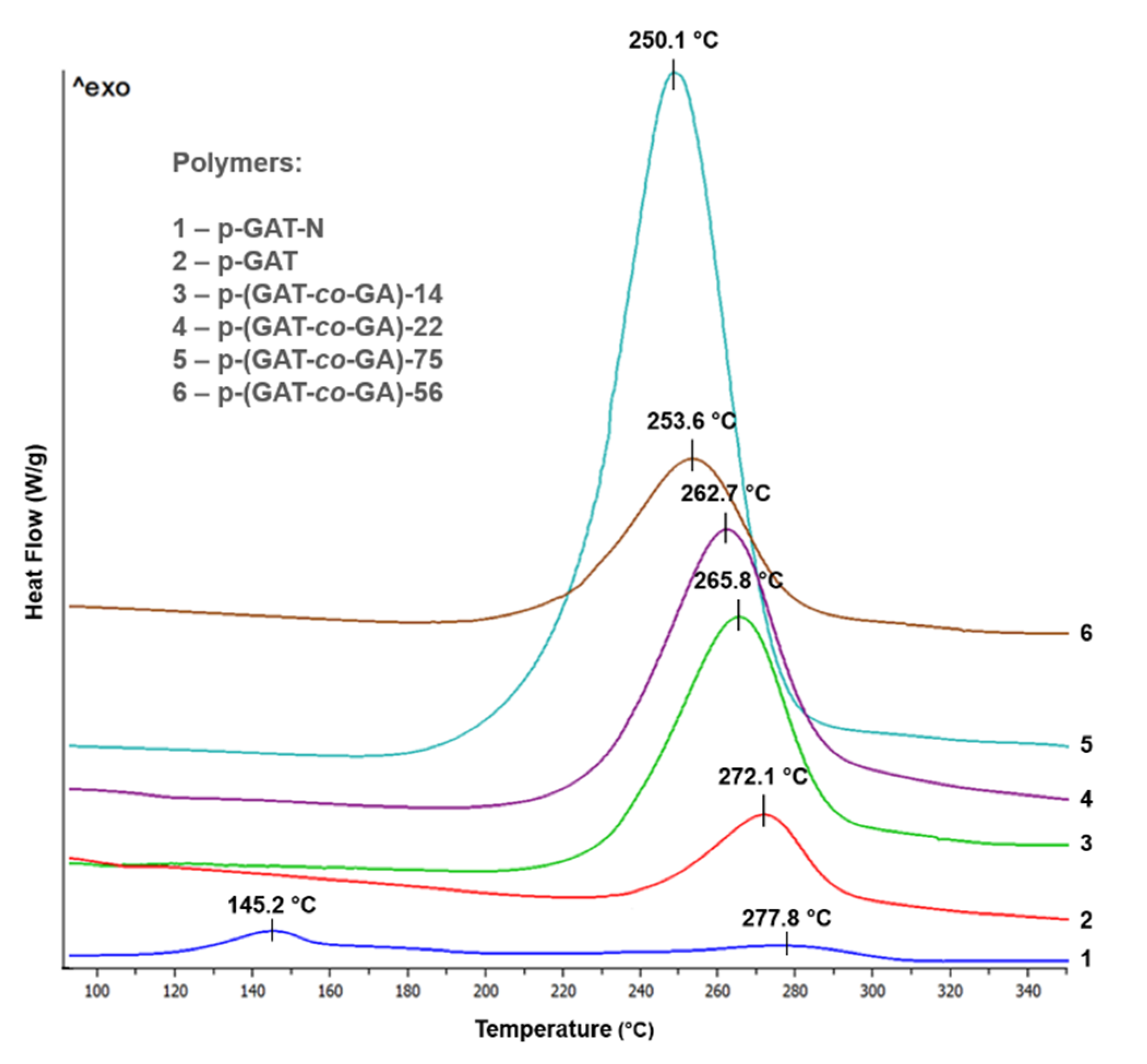
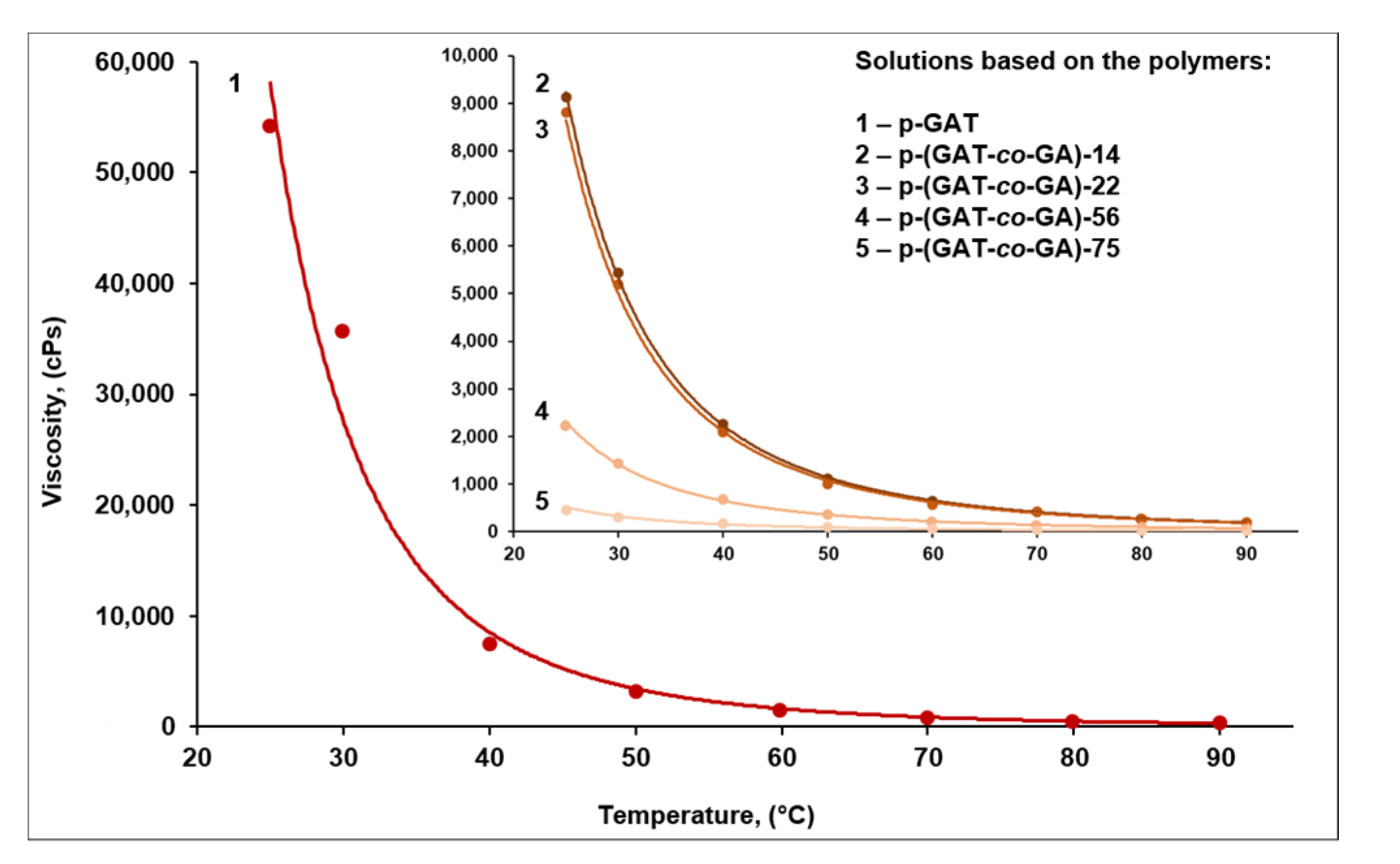
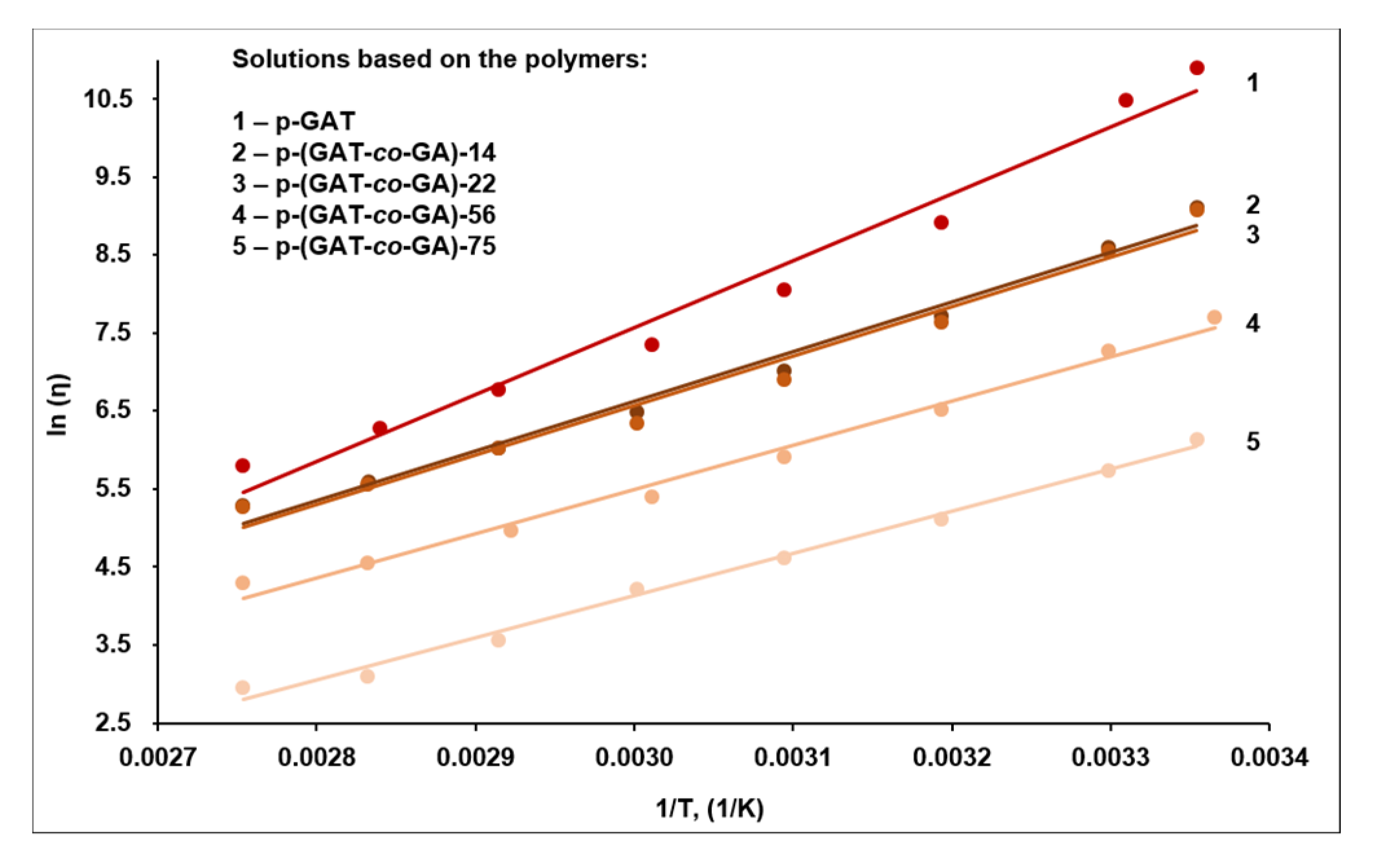

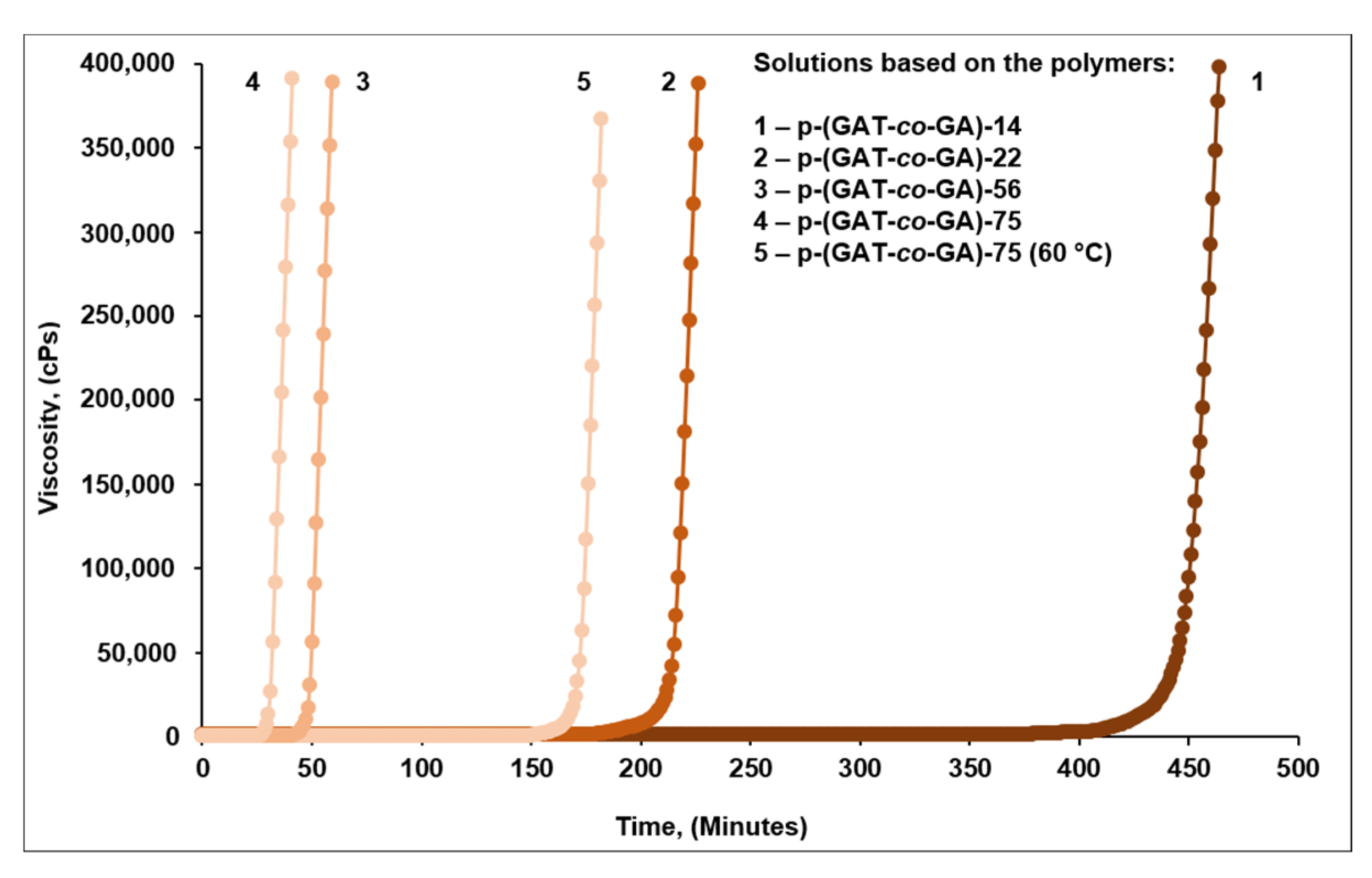

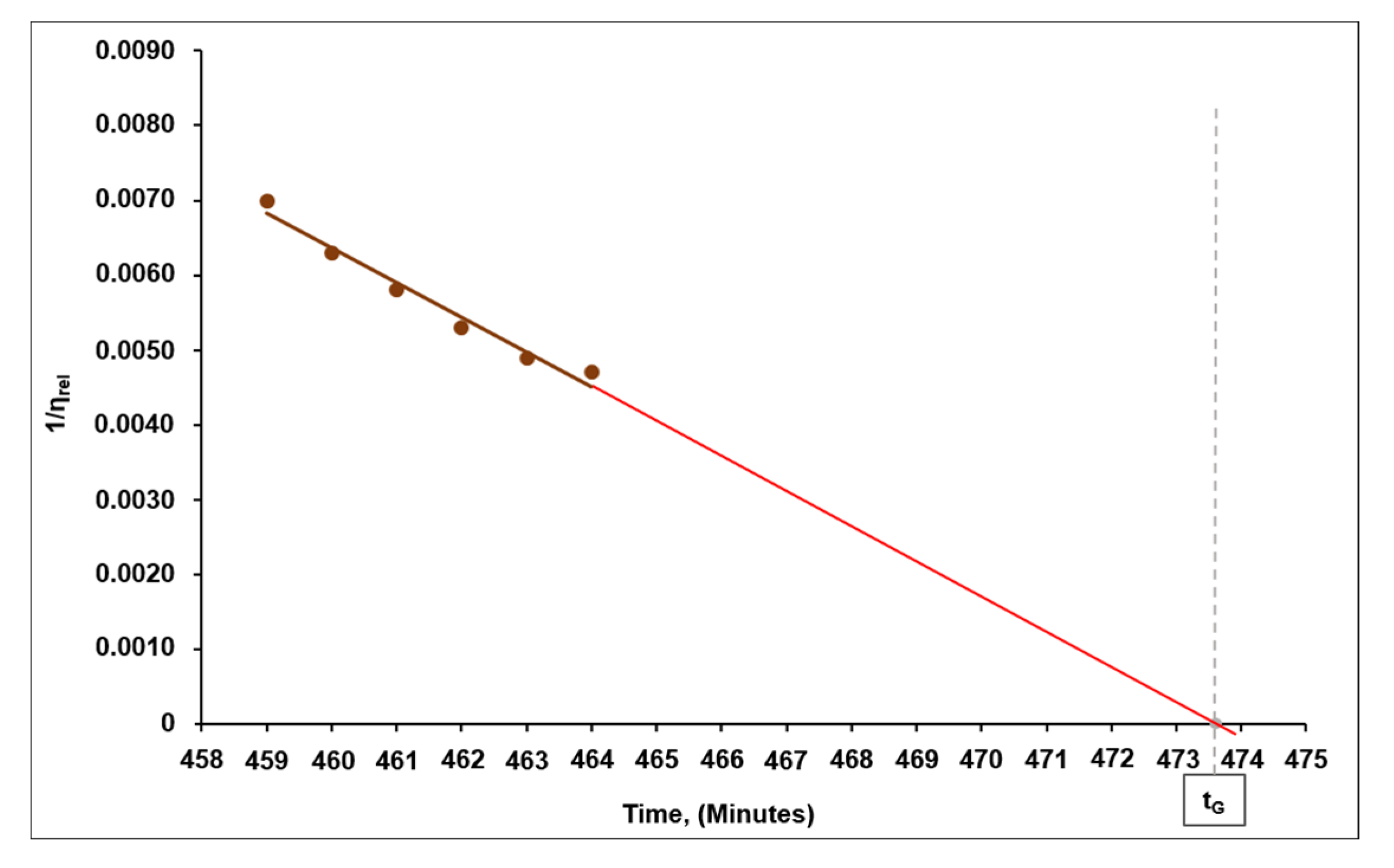
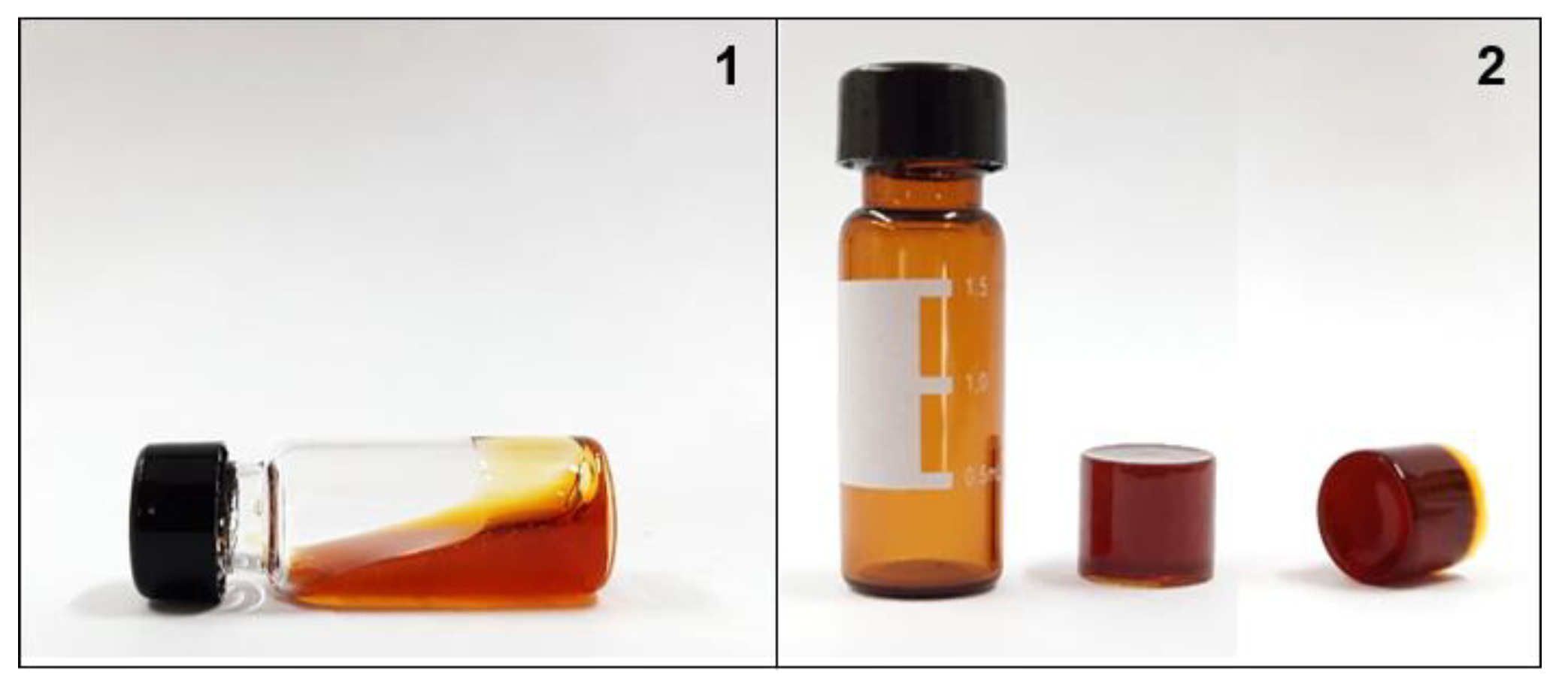
| Polymer | Reactant Ratio, a mmol | Element Ratio, b % mol | Ratio of Isomeric Moieties, c % mol. | Mw d | Mw/Mn d | Yield, % | |||
|---|---|---|---|---|---|---|---|---|---|
| Na5-AT | NaN3 | GAT | GA | N-1 | N-2 | ||||
| p-GAT (homopolymer) | 150 | 0 | 100 | 0 | 42.9 | 57.1 | 5569 | 1.45 | 52 |
| p-(GAT-co-GA)-14 | 135 | 15 | 86.1 | 13.9 | 43.8 | 56.2 | 4041 | 1.33 | 57 |
| p-(GAT-co-GA)-22 | 125 | 25 | 77.7 | 22.3 | 45.7 | 54.3 | 3329 | 1.31 | 62 |
| p-(GAT-co-GA)-56 | 90 | 60 | 44.1 | 55.9 | 48.9 | 51.1 | 2642 | 1.28 | 71 |
| p-(GAT-co-GA)-75 | 75 | 75 | 25.4 | 74.6 | 50.8 | 49.2 | 1643 | 1.26 | 61 |
| GAP (homopolymer) e | 0 | 150 | 0 | 100 | – | – | 1303 | 1.19 | 74 |
| Polymer | Tdec (onset), °C | Tdec (max.), °C | Density, g/cm3 | N Content, % |
|---|---|---|---|---|
| p-GAT (homopolymer) | 243 | 272 | 1.436 ± 0.0002 | 47.95 |
| p-GAT-N | 122 241 | 145 278 | 1.540 ± 0.0008 | 40.10 |
| p-(GAT-co-GA)-14 | 233 | 266 | 1.427 ± 0.0002 | 46.98 |
| p-(GAT-co-GA)-22 | 229 | 263 | 1.413 ± 0.0002 | 46.23 |
| p-(GAT-co-GA)-56 | 225 | 254 | viscous-flow | 43.81 |
| p-(GAT-co-GA)-75 | 220 | 250 | viscous-flow | 42.26 |
| GAP (homopolymer) a | 200 | 246 | 1.284 | 40.95 |
| Polymer | η, a cPs at 25 °C | η, a cPs at 60 °C | η, a cPs at 90 °C | Ea,b kJ/mol | tOG, c min | tLG, d min | tG, e min |
|---|---|---|---|---|---|---|---|
| p-GAT (homopolymer) | 54249 | 1551 | 333 | 71.2 | – | – | – |
| p-(GAT-co-GA)-14 | 9126 | 653 | 200 | 52.9 | 383 | 444 | 474 |
| p-(GAT-co-GA)-22 | 8816 | 568 | 194 | 52.6 | 183 | 214 | 231 |
| p-(GAT-co-GA)-56 | 2220 | 221 | 73 | 47.2 | 41 | 48 | 65 |
| p-(GAT-co-GA)-75 | 460 | 68 | 19 | 45.1 | 26 151 f | 30 172 f | 46 188 f |
Publisher’s Note: MDPI stays neutral with regard to jurisdictional claims in published maps and institutional affiliations. |
© 2022 by the authors. Licensee MDPI, Basel, Switzerland. This article is an open access article distributed under the terms and conditions of the Creative Commons Attribution (CC BY) license (https://creativecommons.org/licenses/by/4.0/).
Share and Cite
Sukhanov, G.T.; Bosov, K.K.; Filippova, Y.V.; Sukhanova, A.G.; Krupnova, I.A.; Pivovarova, E.V. New 5-Aminotetrazole-Based Energetic Polymers: Synthesis, Structure and Properties. Materials 2022, 15, 6936. https://doi.org/10.3390/ma15196936
Sukhanov GT, Bosov KK, Filippova YV, Sukhanova AG, Krupnova IA, Pivovarova EV. New 5-Aminotetrazole-Based Energetic Polymers: Synthesis, Structure and Properties. Materials. 2022; 15(19):6936. https://doi.org/10.3390/ma15196936
Chicago/Turabian StyleSukhanov, Gennady T., Konstantin K. Bosov, Yulia V. Filippova, Anna G. Sukhanova, Irina A. Krupnova, and Ekaterina V. Pivovarova. 2022. "New 5-Aminotetrazole-Based Energetic Polymers: Synthesis, Structure and Properties" Materials 15, no. 19: 6936. https://doi.org/10.3390/ma15196936
APA StyleSukhanov, G. T., Bosov, K. K., Filippova, Y. V., Sukhanova, A. G., Krupnova, I. A., & Pivovarova, E. V. (2022). New 5-Aminotetrazole-Based Energetic Polymers: Synthesis, Structure and Properties. Materials, 15(19), 6936. https://doi.org/10.3390/ma15196936








